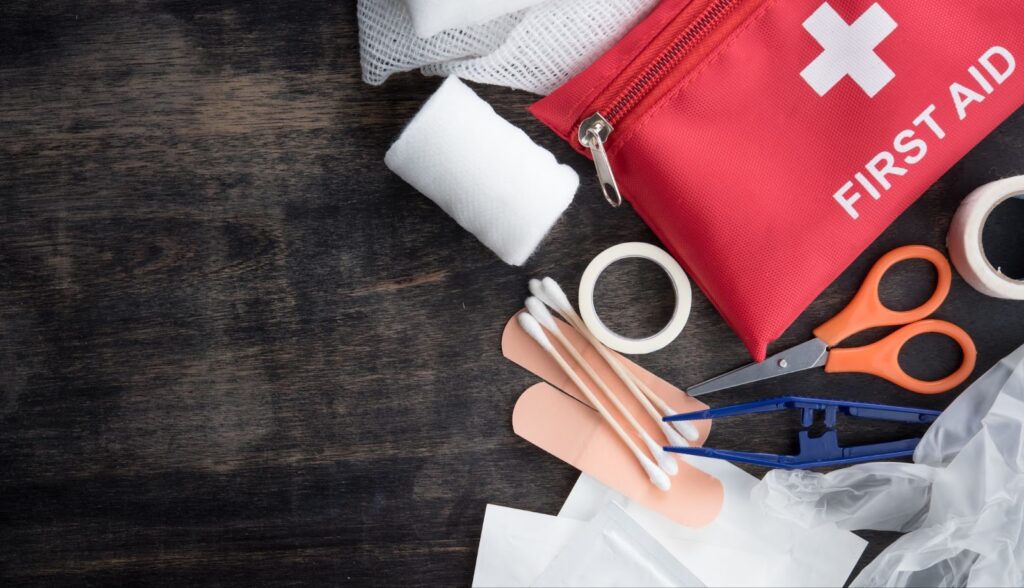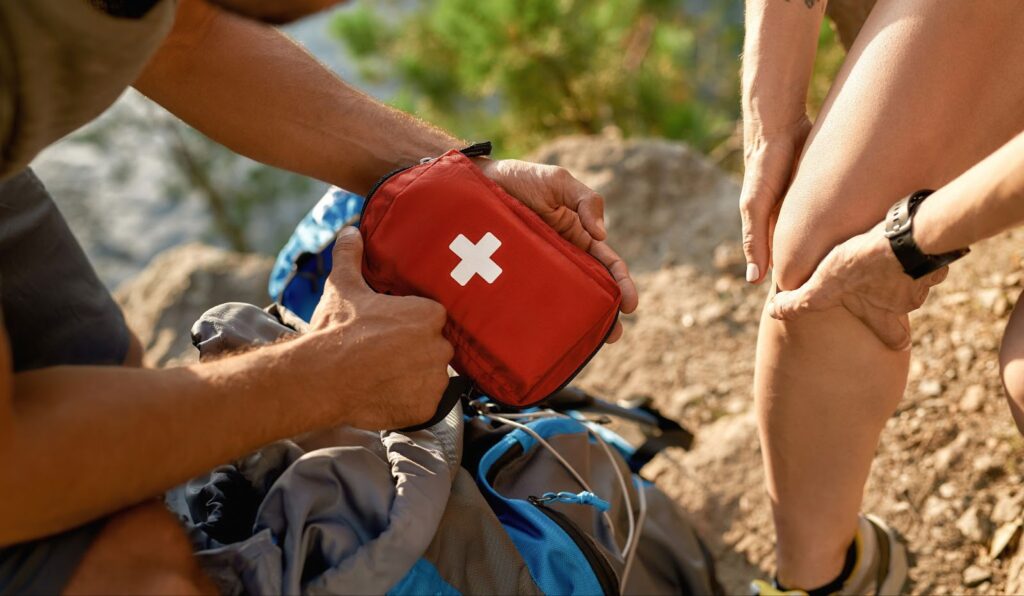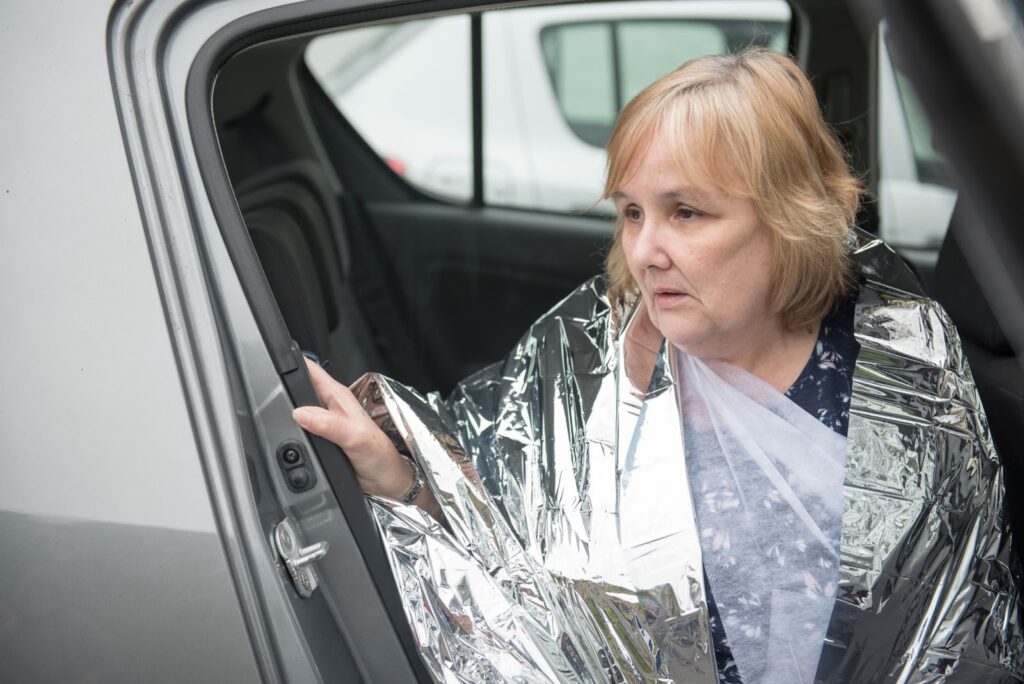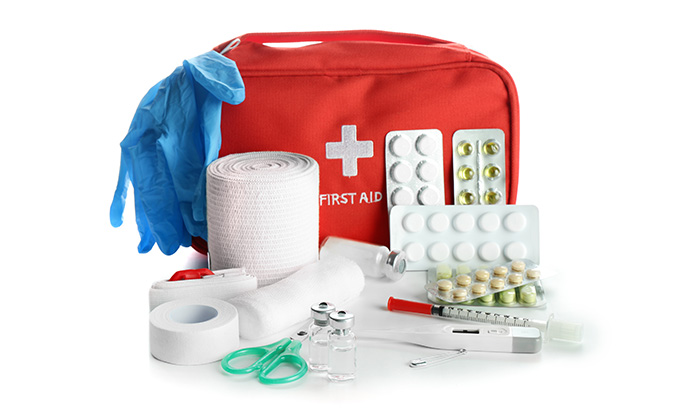Are you curious about first aid kits and wondering, “What does a first aid kit have?” Let’s explore the essentials together!
You cut your finger while prepping dinner, stubbed your toe while rearranging furniture, and your son had a bee sting allergic reaction while playing in the backyard. Adhering to the Boy Scout motto, “Be prepared,” will help you in all these circumstances.
In any home, having a well-stocked first aid kit is a must. You never know when accidents might happen, so having everything you need on hand makes a big difference when someone gets hurt. From minor scrapes to more serious injuries, having the right supplies in your first aid kit is a lifesaver.
So, let’s dive into the importance of a first aid kit at home to make sure you’re ready for whatever comes your way!

First aid kits 101
A first aid kit is a collection of essential medical supplies and equipment compiled to provide immediate care for injuries and medical emergencies. These kits typically contain bandages, antiseptics, adhesive tape, scissors, and pain relievers.
A well-stocked at home first aid kit allows you to respond efficiently to common injuries and situations. Consider purchasing a compact travel-size first aid kit for outings to the park, pool, or when you’re on vacation. For example, if you’re going camping, you might include additional sunscreen, burn treatment, bug repellant, and bite lotion.
Knowing the safest place to store a first aid kit is as important as what you put inside. Your kit should be kept in an area easily accessible in an emergency but out of reach of small children. In addition, you should place a travel version in each of your cars.
Various types of first aid kits are available, each designed to cater to specific needs and situations. Basic first aid kits contain essential supplies for treating minor injuries. Travel kits are designed for use on the go. Sports kits are tailored for athletes and sports enthusiasts. First aid kits should not be confused with survival kits geared towards sustaining life during disasters.

Consider taking a first-aid course with the American Red Cross to get the most out of your first aid kit. To learn more about courses, contact your local chapter. Prepare children for medical situations in an age-appropriate manner as well. Teach them the importance of a first aid kit at home and how to use its contents.
First aid essentials
What does a first aid kit have exactly? Here are several essentials to stock yours with:
- Antiseptics
Keeping a wound clean helps prevent infections by reducing germs and bacteria. To prepare your cleaning kit, include a handful of antiseptic wipe packages, alcohol pads, and bug bite swabs.
Alcohol wipes are ideal for sterilizing equipment and maintaining a germ-free makeshift first-aid station, but they are not used to clean wounds. Alcohol injures tissue and slows healing in exposed wounds.
The simplest approach to clean an open wound is to use warm, soapy water or to run clean water over it for a few minutes. If you don’t have access to clean water, sanitize the wound using alcohol swabs.
- Ointments
Antibiotic ointments and hydrocortisone cream are beneficial to toss in your at home first aid kit. Antibiotic ointment helps prevent infection in minor cuts, scrapes, and burns. Common examples include Neosporin or Bacitracin. Hydrocortisone cream reduces itching, swelling, and irritation from insect bites, rashes, and minor skin irritations.
- Gauze
Gauze is a versatile first-aid supply. It prevents bleeding, keeps a wound dry, and serves as a bandage pad. The distinction between dressings and gauze bandages is that gauze permits airflow into the wound, whereas most dressings do not. Include a range of gauze designs and sizes in your bag, such as gauze roll bandages and medium and large sterile gauze pads for maximum preparedness.
- Tape
Surgical tape is paramount for holding bandages and gauze in place. Not every bandage is self-adhesive, and some adhesives simply don’t work well. Include one sticky cloth tape (about 10 yards long and 1 inch wide) with your kit.
- Thermometer
A thermometer is essential for monitoring body temperature, which may indicate fever or illness. By having a thermometer readily available, you can quickly assess someone’s health status in case of illness or injury. Avoid using glass thermometers because of their shatter factor. If your thermometer requires batteries, include an extra pair.
- Emergency contacts
Quick access to important contact information is crucial in a medical emergency. Your emergency contacts list should include numbers for local emergency services as well as contact information for family members, friends, or neighbors to provide support during an emergency.
Additionally, include any pertinent medical information such as allergies, medications, and existing medical conditions for each household member.
- Scissors
Scissors help cut bandages, gauze, adhesive tape, or clothing to access and treat injuries. Scissors are also effective for removing splinters, cutting medical tape, or trimming dressings to fit properly. Choose a pair of small, sharp scissors with rounded safety tips, and make sure they are easily accessible within your first aid kit for quick use.

- Emergency blanket
Have you ever wondered why there’s an emergency blanket in first-aid kits instead of something cozier? Well, it’s not your ordinary blanket. Think of it more like a huge, thin sheet of aluminum foil — it’s designed to regulate body temperature, thanks to NASA-inspired tech. This comes in handy during emergencies, long electrical outages, or when dealing with certain health conditions.
- Bandages
There are two basic types of bandages: elastic and adhesive. Elastic bandages come in rolls and are used to wrap a sprain wound or to treat edema. Adhesive bandages are single-use and convenient for minor injuries. Both serve distinct purposes in wound care and injury management.
- Dressings
Dressings are used while applying pressure to a wound to halt bleeding, minimize blood loss, and clean up oozing. Dressings are often non-adhesive, which is ideal for burns. Add a couple of absorbent compress dressings to your first aid kit for optimal readiness.
- Disposable gloves
Medical gloves help prevent the spread of illnesses when treating bleeding wounds. They are essential for protecting the responder and the patient from exposure to blood, bodily fluids, and potentially harmful microorganisms during medical emergencies or first aid procedures. Include several sizes depending on who might be using the kit.
- Breathing barriers
A breathing barrier is useful if you need to do CPR, especially on someone you don’t know. While mouth-to-mouth communication may be required to save someone’s life, coming into close contact with their mouth might make you sick if they’re carrying an illness or disease.
Breathing barriers are placed between your mouth and the mouth of the individual you’re performing CPR on. They keep illnesses such as HIV and hepatitis from spreading. Breathing barriers are necessary since these viruses transmit through blood and body fluids, and some people are unaware they are carrying them.
- Hot and cold packs
Hot and cold packs provide quick relief for various injuries and ailments. If you’ve bumped your head or taken a spill, these packs will save the day by reducing pain and swelling. Plus, in the event of a power outage, instant heat or cold packets allow you to administer treatment without relying on appliances like the microwave or freezer.
- Other First aid basic care to consider:
- Nonstick sterile pads
- Blister treatment
- Ibuprofen / other pain-relief medication
- Insect sting / anti-itch treatment
- Antihistamine to treat allergic reactions
- Splinter tweezers
- Safety pins
- First-aid manual or information cards
How to customize your kit
Contemplate your family’s unique healthcare needs when putting together an at home first aid kit. Here are some examples to consider:
- If you have older family members with delicate skin, a roll of paper tape will help preserve their skin.
- If you have a family member with a severe allergy, pack antihistamine medication and an epinephrine injector.
- If you or a family member has diabetes, pack a juice box, glucose pills and gels, and an emergency glucagon injection kit.
- Chewable baby aspirin may benefit someone with coronary artery disease if they are not allergic to aspirin.
First aid kit maintenance
Just as you regularly maintain your appliances or car, keep an eye on your first aid kit. Check and maintain it regularly to ensure it remains adequately stocked, up-to-date, and ready for use in emergencies. Clear out any expired supplies and restock the depleted ones.
In addition to checking supplies, consider including a letter in your kit with guidance on where to find other necessary supplies around the house—further emphasizing the importance of a first aid kit at home. This ensures that all household members know where to locate additional resources in case of emergencies so they are prepared and capable.
Call Black Diamond Restoration today
Dealing with an emergency is never fun, but knowing how to answer, “What does a first aid kit have?” will help you plan ahead. In the event of a natural disaster or other emergency, call for restoration help right away. Black Diamond Restoration is the best in the business for handling restoration problems efficiently.
Having a first aid kit on hand will provide you with peace of mind in the event of an emergency. If your house has been damaged by a disaster such as a flood, fire, or mold, we will assist you right away. Contact Black Diamond Restoration today to get started!
toto slot






